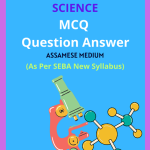Class 7 Science MCQ Chapter 2 Nutrition in Animals Solutions in English Medium, Class 7 Science Multiple Choice Question Answer in English to each chapter is provided in the list so that you can easily browse throughout different chapters Class 7 Science MCQ Chapter 2 Nutrition in Animals Notes and select need one.
Class 7 Science MCQ Chapter 2 Nutrition in Animals
Also, you can read the SCERT book online in these sections Class 7 Science Objective Type Solutions by Expert Teachers as per SCERT (CBSE) Book guidelines. These solutions are part of SCERT All Subject Solutions. Here we have given Assam Class 7 Science MCQs Solutions in English for All Subject, You can practice these here.
Nutrition in Animals
Chapter – 2
| MCQ |
1. Tongue helps in:
(a) Mixing saliva with food.
(b) Swallowing the food.
(c) Speaking.
(d) All the above.
Ans: (d) All the above.
2. The process by which organisms take in food is called:
(a) Ingestion.
(b) Assimilation.
(c) Digestion.
(d) Egestion.
Ans: (a) Ingestion.
3. Which organ secretes bile that aids in digestion?
(a) Stomach.
(b) Pancreas.
(c) Liver.
(d) Small intestine.
Ans: (c) Liver.
4. The total number of teeth in a permanent set is:
(a) 32.
(b) 30.
(c) 29.
(d) 16.
Ans: (a) 32.
5. What is the correct order of the human digestive process?
(a) Ingestion, absorption, digestion, assimilation, egestion.
(b) Digestion, ingestion, absorption, assimilation, egestion.
(c) Ingestion, digestion, absorption, assimilation, egestion.
(d) Assimilation, ingestion, digestion, absorption, egestion.
Ans: (c) Ingestion, digestion, absorption, assimilation, egestion.
6. Bile helps to:
(a) Digest carbohydrates.
(b) Digest proteins.
(c) Digest fats.
(d) Digest cellulose.
Ans: (c) Digest fats.
7. How does an Amoeba ingest its food?
(a) Using its mouth.
(b) Using its pseudopodia.
(c) Using its tentacles.
(d) Using its cilia.
Ans: (b) Using its pseudopodia.
8. Partially digested food in the rumen is called:
(a) Rumen.
(b) Cud.
(c) Saliva.
(d) Grass.
Ans: (b) Cud.
9. In amoeba, food particle is trapped inside a cavity called:
(a) Food vacuole.
(b) Pseudopodia.
(c) Villi.
(d) Cud.
Ans: (a) Food vacuole.
10. What are grazing animals like cows and buffaloes known as?
(a) Carnivores.
(b) Omnivores.
(c) Ruminants.
(d) Herbivores.
Ans: (c) Ruminants.
11. The proboscis is present in:
(a) Housefly.
(b) Cockroach.
(c) Butterfly.
(d) Lizard.
Ans: (c) Butterfly.
12. The sting cells are present in:
(a) Amoeba.
(b) Paramecium.
(c) Euglena.
(d) Hydra.
Ans: (d) Hydra.
13. Where does the digestion of carbohydrates like starch begin?
(a) Stomach.
(b) Buccal cavity.
(c) Small intestine.
(d) Large intestine.
Ans: (b) Buccal cavity.
14. Which of the following are called the tearing teeth?
(a) Incisors.
(b) Canines.
(c) Molars.
(d) Premolars.
Ans: (b) Canines.
15. Ruminants can:
(a) Digest the cellulose.
(b) Not digest the cellulose.
(c) Sometimes digest and sometimes do not.
(d) All of the above.
Ans: (a) Digest the cellulose.

Hi! my Name is Parimal Roy. I have completed my Bachelor’s degree in Philosophy (B.A.) from Silapathar General College. Currently, I am working as an HR Manager at Dev Library. It is a website that provides study materials for students from Class 3 to 12, including SCERT and NCERT notes. It also offers resources for BA, B.Com, B.Sc, and Computer Science, along with postgraduate notes. Besides study materials, the website has novels, eBooks, health and finance articles, biographies, quotes, and more.



